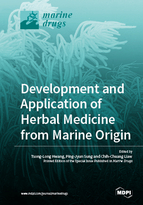Development and Application of Herbal Medicine from Marine Origin
A special issue of Marine Drugs (ISSN 1660-3397).
Deadline for manuscript submissions: closed (28 February 2019) | Viewed by 45305
Special Issue Editors
Research Center for Chinese Herbal Medicine, College of Human Ecology, Chang Gung University of Science and Technology, Taiwan
Interests: neutrophilic inflammation; innate immunity; signal transduction; protein kinase; drug research and development
Special Issues, Collections and Topics in MDPI journals
Interests: marine natural products; marine chemical ecology; bioactive substances from cultured marine invertebrates
Special Issues, Collections and Topics in MDPI journals
2. Doctoral Degree Program in Marine Biotechnology, National Sun Yat-sen University, Kaohsiung, 80424, Taiwan
3. Graduate Institute of Natural Products, Kaohsiung Medical University, Kaohsiung 807, Taiwan
4. Graduate Institute of Pharmacognosy, Taipei Medical University, Taipei 110, Taiwan
Interests: marine microbial natural products, de-replication, symbiotic microbes, biofunctional activities
Special Issue Information
Dear Colleagues,
Marine herbal medicine generally refers to the use of marine plants as original materials to develop crude drugs, or for other medical use. The term ‘marine plants’ usually denotes macroalgae grown between intertidal and sub-intertidal zones, including Chlorophyta, Phaeophyta and Rhodophyta. Considerable progress has been made in the field of biomedical research into marine microalgae and microorganisms in the past decade. As the most important source of fundamental products in the world, marine plants have a very important role in biomedical research. Furthermore, worldwide studies have consistently demonstrated that many crude drugs derived from marine plants contain novel ingredients that may benefit health or can be used in the treatment of diseases; some have been developed into health foods, and some even into drugs. It is expected that there are many substances of marine plant origin that will have medical applications in terms of improving human health, and are awaiting discovery.
In this Special Issue, Development and Application of Herbal Medicine of Marine Origin, we will provide a platform for researchers to publish biomedical studies on substances of marine plant origin. We welcome submissions from scientists and academics from across the world. Selected papers from this conference "The 33rd Symposium on Natural Products" (https://nphs.kmu.edu.tw/index.php/zh-TW/nph33) will also be considered to be published in this Special Issue.
Prof. Dr. Tsong-Long Hwang
Prof. Dr. Ping-Jyun Sung
Assoc. Prof. Dr. Chih-Chuang Liaw
Guest Editors
Manuscript Submission Information
Manuscripts should be submitted online at www.mdpi.com by registering and logging in to this website. Once you are registered, click here to go to the submission form. Manuscripts can be submitted until the deadline. All submissions that pass pre-check are peer-reviewed. Accepted papers will be published continuously in the journal (as soon as accepted) and will be listed together on the special issue website. Research articles, review articles as well as short communications are invited. For planned papers, a title and short abstract (about 100 words) can be sent to the Editorial Office for announcement on this website.
Submitted manuscripts should not have been published previously, nor be under consideration for publication elsewhere (except conference proceedings papers). All manuscripts are thoroughly refereed through a single-blind peer-review process. A guide for authors and other relevant information for submission of manuscripts is available on the Instructions for Authors page. Marine Drugs is an international peer-reviewed open access monthly journal published by MDPI.
Please visit the Instructions for Authors page before submitting a manuscript. The Article Processing Charge (APC) for publication in this open access journal is 2900 CHF (Swiss Francs). Submitted papers should be well formatted and use good English. Authors may use MDPI's English editing service prior to publication or during author revisions.
Keywords
-
Herbal medicine
-
Algae
-
Microorganism
-
Biomedicine
-
Disease
-
Drug








